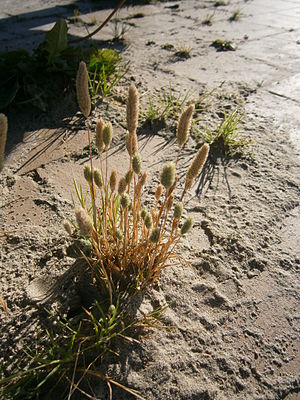Sand timothy grass
| Sand timothy grass | ||||||||||||
|---|---|---|---|---|---|---|---|---|---|---|---|---|

Sand timothy ( Phleum arenarium ) |
||||||||||||
| Systematics | ||||||||||||
|
||||||||||||
| Scientific name | ||||||||||||
| Phleum arenarium | ||||||||||||
| L. |
The sand timothy ( Phleum arenarium ) is a species of timothy ( Phleum ) within the sweet grass family (Poaceae). This pioneer plant is mainly found on and near the coasts of western and southern Europe.
description
Vegetative characteristics
The timothy grass is a deciduous, annual herbaceous plant and reaches heights of 5 to 20 centimeters. This grass grows in loose clumps or individually. The upright or from the base upwardly curved, thin, smooth stalks have one to four nodes ( nodes ) below the stem center.
The leaf sheaths are smooth and round on the back; the upper ones appear a little puffed up. The 1 to 5 millimeter long ligule are entire and pointed. The whitish-green, bare leaf blades are indistinctly grooved on top, finely roughened on the edges and narrowed into a thin point and measure up to 3 millimeters wide and 5 centimeters long.
Generative characteristics
The flowering period extends from May to July. The very dense and therefore spike-like appearing, panicle inflorescence is whitish green. The inflorescence is up to 4 centimeters long and up to 7 millimeters wide, cylindrical to obovate and usually narrowed at the base, rounded at the tip and appears lobed when bent. The single-flowered spikelets have two blunt glumes separated to the base with an attached lateral awn . The spikelets appear two-pointed and clipped (" boot servant-like ") - a characteristic feature of timothy grass species. The lemmas are not awned.
The number of chromosomes is 2n = 14.
ecology
The sand timothy is a therophyte .
Occurrence
Sand timothy grass is widespread in large parts of Europe, especially along and near the coasts of Western Europe from Sweden south and east to the Mediterranean , and is very common locally. It occurs mainly around the coasts of the British Isles on the Atlantic coast of the Netherlands , Belgium and France and on the Mediterranean coast of France and Italy . It grows less often on sandy soils inland . In Germany it occurs sparsely or rarely on the North and Baltic Sea coasts. Phleum arenarium is a neophyte in North America, Australia and New Zealand and occurs there also in sand habitats.
The timothy grass thrives best on warm and dry, slightly nitrogen-influenced, base-rich, humus and fine earth poor , loose sandy soils . This salt-bearing pioneer grass predominantly colonizes gappy locations in coastal dunes and is characteristic of the short-lived plant community of the tortulo phleetum, which is dependent on periodic soil wounds. Sometimes it occurs in inland dunes in the company Bromo-Phleetum arenarii Korneck 1974 from the association Sileno conicae-Cerastion semidecandri and on drifting sand fields inland, on sandy roadsides and in sand pits. There the sand timothy also likes to grow in subatlantic sandy grasslands and is locally the characteristic species of the society of Agrostio-Poetum humilis Tx. ex Menke 1969.
Hazard and protection
The timothy grass is considered to be endangered in Central Europe, but enjoys no legal protection. In Germany, the species is listed as critically endangered on the Red List of Endangered Plants. In Mecklenburg-Western Pomerania the species is considered threatened with extinction.
The endangerment of the species is essentially based on the destruction of the place of growth, especially through the development and the entering and driving of coastal and inland dunes as well as the displacement by neophytes . Furthermore, small-scale special locations are endangered by sand mining, but also by shrub and forest cover in the course of natural succession.
Sources and further information
literature
- Henning Haeupler, Thomas Muer: picture atlas of the fern and flowering plants of Germany . Ed .: Federal Agency for Nature Conservation (= The fern and flowering plants of Germany . Volume 2 ). Eugen Ulmer, Stuttgart (Hohenheim) 2000, ISBN 3-8001-3364-4 .
- Charles Edward Hubbard: Grasses. Description, distribution, use (= UTB . Volume 233 ). 2nd, revised and expanded edition. Eugen Ulmer, Stuttgart (Hohenheim) 1985, ISBN 3-8001-2537-4 (English: Grasses . Translated by Peter Boeker).
- Erich Oberdorfer : Plant-sociological excursion flora . With the collaboration of Theo Müller. 6th, revised and expanded edition. Eugen Ulmer, Stuttgart (Hohenheim) 1990, ISBN 3-8001-3454-3 .
- Directory and Red List of Plant Societies in Germany (as of October 30, 2000)
Individual evidence
- ↑ a b c Erich Oberdorfer : Plant-sociological excursion flora for Germany and neighboring areas . 8th edition. Verlag Eugen Ulmer, Stuttgart 2001, ISBN 3-8001-3131-5 . Page 257.
Web links
- Phleum arenarium L., Timothy grass. In: FloraWeb.de.
- Sand timothy grass . In: BiolFlor, the database of biological-ecological characteristics of the flora of Germany.
- Profile and distribution map for Bavaria . In: Botanical Information Hub of Bavaria .
- Distribution in the northern hemisphere from to Hultén near Den virtuella flora .
- Thomas Meyer: Data sheet with identification key and photos at Flora-de: Flora von Deutschland (old name of the website: Flowers in Swabia )


